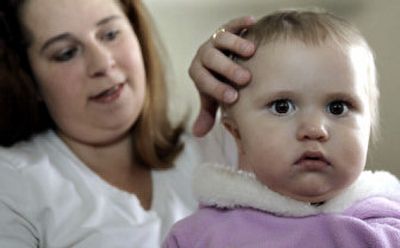Children can suffer strokes

WASHINGTON – It looked like a seizure when little Alexzandra Gonzales jerked and then went limp, barely breathing. A frantic race to the hospital led to a diagnosis her parents found hard to believe: Just days before her first birthday, she had had a stroke.
“We never knew that children could have strokes,” says her mother, Amanda Gonzales.
It’s a common misconception, yet several thousand U.S. children a year suffer strokes – and some specialists fear they’re on the rise. Only now are efforts under way to detect strokes faster in these smallest patients and begin figuring out how to treat them, to help rescue their brains.
“It gets short shrift,” complains Dr. Raymond Pitetti, assistant emergency medicine chief at Children’s Hospital of Pittsburgh, who developed a “stroke team” for kids, to speed diagnosis after counting an increase in victims in his emergency room.
“There are a lot of knowledge gaps,” agrees Dr. John Lynch of the National Institutes of Health, whose research is pointing to possible unrecognized genetic culprits.
Strokes are rare in children. Still, Lynch estimates that about 1,000 infants a year suffer a stroke during the newborn period or before birth – plus anywhere from 3,000 to 5,000 children from age 1 month to 18 years.
The age difference is important, as newborn strokes appear to be distinctly different from those in older babies and children, who are more at risk for repeat brain attacks.
Between 10 and 25 percent of pediatric stroke sufferers die.
Specialists once thought most survivors eventually would recover, because children’s brains are much more “plastic” than adults’ – they’re more likely to reroute themselves around damage. But sobering research now shows more than half will have permanent motor or cognitive disabilities.
“Kids in the end still do better than adults,” cautions Dr. Amy Goldstein, a pediatric neurologist at Children’s Hospital of Pittsburgh, noting that “it’s hard to keep a 2-year-old still,” while the elderly may not be as motivated for necessary physical therapy.
Worse, there’s very little research on how to treat child stroke. Neurologists cobble together therapy based on what works in adults, although what causes most adult strokes – hardened, clogged arteries – isn’t the culprit for youngsters, and few are diagnosed fast enough to try experimentally the drug tPA that can restore their elders’ blocked blood flow.
Efforts are under way to change that. An international study, led by Toronto’s Hospital for Sick Children, is trying to pinpoint risk factors and patients’ outcomes based on how different hospitals care for them, and what kind of knowledge is necessary to devise new treatments.
While cardiac birth defects, vascular abnormalities, sickle cell disease and certain infections can trigger child strokes, doctors never find a cause for about two-thirds of cases. A second study, led by NIH’s Lynch, suggests many of them harbor genetic mutations connected to blood clotting and metabolism, a possible missing link.
And about 100 patients are enrolled in a study of whether Pitetti’s stroke team improves their outcomes by speeding diagnosis.
For now, pediatric stroke treatment focuses on preventing a repeat stroke and minimizing damage from the first one.
Consider Alexzandra Gonzales. Raced to the Pittsburgh hospital July 24, she suffered another stroke three days later, on her birthday. Surgeons cut out a portion of her skull to relieve massive brain swelling and prevent further damage. When she woke up a week later, she was like a newborn, unable even to hold her head up.
After four months of hospitalization and intensive therapy at a rehabilitation unit, today the Connellsville, Pa., toddler can sit, roll over and stand with support, although she still is weak on one side.
“So far, she has beaten all the odds and has surprised everybody,” Gonzales says.
Doctors aren’t sure what caused Alexzandra’s stroke, but she was lucky: Her parents raced her to a local hospital that immediately recognized she needed neurology care.
Too often, children face a significant delay, say Pitetti and Goldstein. Hospitals frequently make stroke a diagnosis of last resort. Parents may not recognize acute stroke symptoms – such as one-sided weakness, loss of speech and, in babies, seizures.
And if your baby seems to favor one side, insist on a neurology exam – it might be an undetected newborn stroke that requires physical therapy, Goldstein adds.
“Moms need to trust their gut instinct,” she says. “Know this can happen.”